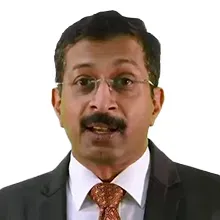About Doctor DR. SATHYAKI NAMBALA
About
Dr. Sathyaki Nambala is a leading cardiothoracic and Vascular Surgeon in Bengaluru. He has been performing heart, lung, and vascular surgery for the past 18 years. He is the
first surgeon in India to do robotic heart surgery. He earned his MBBS from the University of Mysore in India in 1995, his MCh in Cardio-Thoracic Surgery from SCTIMS in 2004, and his MS in General Surgery from RGUHS in 2000. He is a specialist in CABG, difficult aortic root surgery, minimally invasive valve surgery, and aortic valve repair surgery. The Karnataka Medical Council counts him as a contributing member. Dr. Sathyaki is renowned for his expertise in challenging cardiac surgeries and has a wealth of experience doing intricate valve repairs. Additionally, he has extensive knowledge of pediatric cardiac surgery. Aortic aneurysm surgery, aortic valve repair, difficult aortic root surgery, minimally invasive valve and CABG surgery, heart failure surgery, including the artificial heart (Assist Devices), and heart transplant are among the areas of specialization of Dr. Nambala.
Work Experience:
18 Years of Experience
At Apollo Hospitals, Bannerghatta Road, Dr. Sathyaki Purushotam Nambala practises cardiothoracic and vascular surgery as a senior consultant. Dr. Sathyaki is renowned for his expertise in challenging cardiac procedures and has extensive experience in difficult valve repairs after earning his MBBS, MS (Gen Surgery), and MCh (Cardio-Thoracic Surgery) degrees. He is well known for using a keyhole to do difficult heart valve replacements and repairs, a procedure known as Totally Endoscopic Heart Surgery. Prior to joining Apollo Hospitals, he served as a physician at prestigious institutions such Brigham & Women's Hospital (BWH), Sri Chitra Tirunal Institute for Medical Sciences and Technology, and Harvard Medical School, Boston. Dr. Nambala is a specialist in paediatric cardiac surgery, aortic aneurysm repair, difficult aortic root surgery, and aortic valve replacement.
Associated with Hospitals:
Apollo hospital, Chennai
List of Treatments:
Dr. Sathyaki Nambala being a senior cardiothoracic surgeon is available for following treatments:
-
Heart Failure: Heart failure occurs when the heart muscle fails to adequately pump blood. Blood frequently backs up, causing fluid to accumulate in the lungs and legs. Medications are often prescribe by the doctor for the treatment of heart failure and sometimes a heart surgery depending on the severity of heart’s condition.
-
Implantation of Pacemaker: Pacemaker implantation is a technique that involves inserting a tiny battery-powered device known as a pacemaker into your chest. The pacemaker provides regular electrical impulses to your heart, which helps it beat normally. The surgeon connects the lead's tip to your heart and the other end to the pacemaker box.
-
Coronary revascularization surgery: Coronary revascularization is a group of treatments or procedures that restore blood flow to areas of your heart that aren't getting enough blood to meet their needs. Rather than open-heart surgery, your surgeon attaches (grafts) a healthy vessel (often taken from the leg) to the diseased or narrowed heart vessel. After that, blood "bypasses" the sick spot and goes through the new channel.
-
Cardiac OPD Procedures: Cardiac OPD operations are those that are conducted on a regular schedule and do not need a hospital admission. History taking, examination, blood tests, the electrocardiogram, event evaluation, cardiac stress testing, electrophysiological study, and other procedures are conducted in the cardiac OPD.
-
Intravascular ultrasound (IVUS): Your cardiologist can use IVUS to see your aorta and coronary arteries (blood vessels that deliver blood to the heart) in amazing detail. The examination exposes your artery walls in greater detail than coronary angiography, including any development of fat deposits (plaque). IVUS is a relatively safe technique.
-
Aortic Aneurysm Surgery: Depending on the location of the ruptured vessel, the surgeon first create a big cut in stomach or chest. The blood vessel is then eliminated and the transplant stitched in its place. This transplant is often a leak-proof polyester tube. The recovery time for open surgical repair is around one month.
-
Heart Transplant: A heart transplant is a procedure that replaces a failing heart with a healthy donor heart. Heart transplantation is often reserved for patients whose health has not improved sufficiently with medicines or other surgical procedures. While a heart transplant is a significant surgery, with proper follow-up treatment, your chances of survival are strong.
-
Congenital heart repairs: Open surgery is often used to correct congenital heart abnormalities. However, in rare situations, similar treatments can be performed utilizing minimally invasive approaches. Catheter treatments or surgery are used by doctors to fix congenital heart abnormalities. Your child's therapy will be determined by the kind and severity of his or her heart problem.
-
Minimal invasive cardiac surgery: It is a surgical procedure in which instead than cutting through the breastbone as in open-heart surgery, minimally invasive cardiac surgery entails making tiny incisions on the right side of the chest to reach the heart between the ribs. A number of cardiac problems can be treated using minimally invasive heart surgery.
-
VAD: A ventricular assist device (VAD) is a device that assists in the pumping of blood from the heart's lower chambers to the rest of the body. It is used to treat a weak heart or heart failure. A VAD may be used to assist the heart while alternative therapies, such as a heart transplant, are being considered.
Awards and recognitions:
He has gained recognition for performing complicated heart valve replacements/repairs via a keyhole also termed Totally Endoscopic Heart Surgery.
Education & Training:
-
MBBS - University Of Mysore, India, 1995
-
MS - General Surgery - RGUHS, 2000
-
MCh - Cardio Thoracic Surgery - SCTIMS, 2004
-
Fellowship in Cardiac Surgery - Harvard Medical School, USA, 2008
Trainings/Specializations:
-
Cardiothoracic Surgeon
-
Cardiac Surgeon
Membership:
Registrations:
40296 Karnataka Medical Council, 1995
Specialty Interests:
 Associated with hospitals
Associated with hospitals
Envisioning the goals & paving the path to success for the organization.
Book Appoinment
Similar Doctors In Bengaluru
Envisioning the goals & paving the path to success for the organization.

















